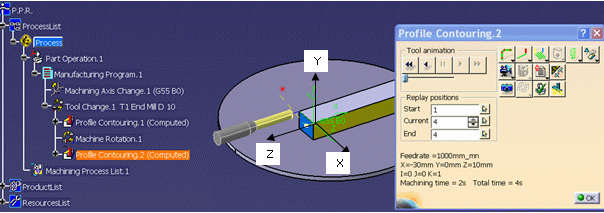In V5 Machining workbenches, the origin of the machining axis is fixed on the NC machine.
When a table rotation is performed:
the machining axis origin moves: it is rotated with the machined part during the table rotation (defined by a manual or automatic machine rotation or by a machine instruction)
the machining axis direction (X, Y, Z) remain parallel to the NC machine axis.
The machining coordinates in the Tool Path replay and APT output are generated according to the machining axis computed with the table rotation.
After a rotation, the tool motion coordinates are defined in the axis system defined by the matrix generated for the rotation (CATIAO matrix).
However, some user's methodology imposes the definition of a machining axis origin that is fixed on the machined part.
Prior to V5R18, this meant the user was required to create a machining axis and insert a Machining Axis Change after an activity on which a table rotation is done.
As from V5R18, a Machining Axis Origin with Fixed on the part after table rotation option is available in Tools > Options > Machining > Output to specify that the machining axis origin will be linked to the machined part when a table rotation is done.
The behavior of the Machining Axis Origin with Fixed on the part after table rotation option is described below.
If the option is selected, the origin axis of a machining axis system is defined as linked to the machined part. So it is kept at the same location when a table rotation is done.
If the option is not selected: the machining axis origin moves according to the table rotation defined on the machining program. This is the behavior that was always applied prior to V5R18.
Note: If the Machine rotation activity contains only a head rotation, then the behavior, tool path replay, and APT output are the same as prior to V5R18.
If the option is selected, the coordinates of tool motion that follow a Machine Rotation or Machine Instruction or Transition Path (that include a table rotation) are defined in the current machining axis system (see current machining axis system highlighted in black in the figure below).

The current machining axis system is defined as follows:
Directions are defined from the previous machining axis system and the table rotation angles are defined from the current machining operation.
Origin axis is the same as in the previous machining axis change defined in the program (or the one defined on the Part operation).
If the option is selected, the CATIAO matrix generated for a table rotation (included in Machine Rotation, Machine Instruction, or Transition Path) automatically ensures that the machine axis origin is kept during the rotation. The axis origin is the same as in the previous machining axis change defined in the program.
If no Machining axis change is defined before the replayed operation, the origin axis is the same as the origin of the machining axis defined on the part operation.
Example:
The coordinates of the origin are the same as defined in the previous machining
axis change (or in the first machining axis defined on the program).
$$ End of generation of : Profile Contouring.1
$$ OPERATION NAME : Machine Rotation.1
$$ Start generation of : Machine Rotation.1
ROTABL/ 270.000000,BOTH
$$*CATIA0
$$ UNKNOWN
$$ 0.00000 0.00000 -1.00000 -40.00000
$$ 0.00000 1.00000 0.00000 20.00000
$$ 1.00000 0.00000 0.00000 30.00000
$$ End of generation of : Machine Rotation.1
$$ OPERATION NAME : Profile Contouring.2
$$ Start generation of : Profile Contouring.2
If the new option is not activated, the axis origin moves.
Example:
The coordinates are generated according to the table rotation angle.
$$ End of generation of : Profile Contouring.1
$$ OPERATION NAME : Machine Rotation.1
$$ Start generation of : Machine Rotation.1
ROTABL/ 270.000000,BOTH
$$*CATIA0
$$ UNKNOWN
$$ 0.00000 0.00000 -1.00000 -30.00000
$$ 0.00000 1.00000 0.00000 20.00000
$$ 1.00000 0.00000 0.00000 -40.00000
$$ End of generation of : Machine Rotation.1
$$ OPERATION NAME : Profile Contouring.2
$$ Start generation of : Profile Contouring.2
If user has imported the APT and the option is selected, then in the Tool Path Replay dialog box will show updated coordinates for Machine Rotation, Machine Instruction, and Transition Path.
Now if the user generates the APT with the option activated, the APT output will show that the CATIAO matrix generated for a table rotation (included in a Machine Rotation, Machine Instruction, or Transition Path) automatically ensures that the machine axis origin is kept during the rotation.
The axis origin is the same as that defined in the previous machining axis change defined in the program. If no Machining axis change is defined before the replayed operation, the origin axis is the same as the origin of the machining axis defined on the part operation.
If user selects the option on a program where all the manufacturing operations are already computed, the coordinates in the Tool Path Replay dialog box will be updated for Machine Rotation, Machine Instruction, and Transition Path.
Now if the user generate the APT with the option activated, the APT output will show that the CATIAO matrix generated for a table rotation (included in Machine Rotation, Machine Instruction, or Transition Path) automatically ensures that machine axis origin is kept during the rotation.
The axis origin is the same as that defined in the previous machining axis change defined in the program. If no Machining axis change is defined before the replayed operation, the origin axis is the same as the origin of the machining axis defined on the part operation.